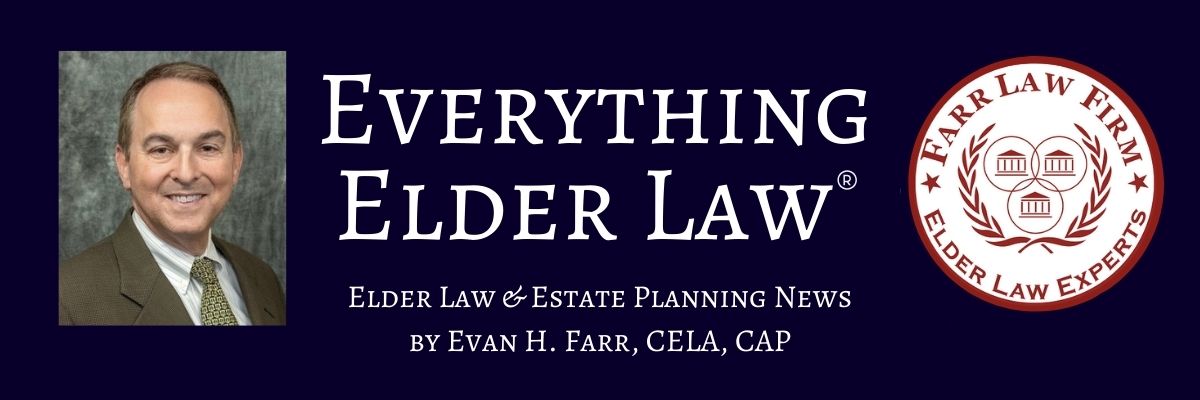 Q. My wife, Patty, and I are in our late 50’s and have been hit hard by COVID-19. Luckily, neither of us got the virus, but financially, we have been struggling. I got furloughed from my job and Patty teaches yoga, and the yoga studio where she teaches, like so many others during this pandemic, had to close completely, so neither of us has had any income for months. We own our home and a vacation home, but we have almost used up our emergency savings. I have a traditional IRA of 250K and Patty has a 403(b) in the amount of $150K from a previous employer. We are both healthy, yet we are seeking Medicaid planning advice (mostly to protect our home and our vacation home) at a time when it seems likely we can get beyond the five year look back period with relative ease. Due to the provision in the CARES Act regarding penalty-free withdrawals of up to $100K from an IRA per person, we are considering withdrawing $100K each from our IRAs to help make ends meet.
Q. My wife, Patty, and I are in our late 50’s and have been hit hard by COVID-19. Luckily, neither of us got the virus, but financially, we have been struggling. I got furloughed from my job and Patty teaches yoga, and the yoga studio where she teaches, like so many others during this pandemic, had to close completely, so neither of us has had any income for months. We own our home and a vacation home, but we have almost used up our emergency savings. I have a traditional IRA of 250K and Patty has a 403(b) in the amount of $150K from a previous employer. We are both healthy, yet we are seeking Medicaid planning advice (mostly to protect our home and our vacation home) at a time when it seems likely we can get beyond the five year look back period with relative ease. Due to the provision in the CARES Act regarding penalty-free withdrawals of up to $100K from an IRA per person, we are considering withdrawing $100K each from our IRAs to help make ends meet.
Is it a wise idea for us to take advantage of the $100K per person withdrawal from our traditional IRAs? It is my understanding that the $100K withdrawal in calendar year 2020 avoids the 10% penalty for early withdrawal, and would also allow us to stretch the amount over 3 years for income tax purposes. For my wife and I, does it have any implications as far as Medicaid planning goes? Are there any other reasons not to do it? Thanks for your help!
—-
A. If you’re out of work and need income due to the coronavirus pandemic, withdrawing from your retirement savings may be a wise idea at this time. Normally, if you withdraw money from a traditional Individual Retirement Accounts (IRA) or an employer-provided retirement account before reaching age 59½, you have to pay a 10% penalty for early withdrawal, but changes to IRS rules that are in effect this year only eliminate that penalty.
If the pandemic has had negative effects on your finances, temporary changes to the rules under the Coronavirus Aid, Relief, and Economic Security Act (CARES) Act give you the flexibility to make a penalty-free withdrawal of up to $100,000 from tax-deferred retirement accounts during 2020.
- IRA owners who are adversely affected by the coronavirus pandemic are eligible to take tax-favored coronavirus-related distributions (CVDs) from their IRAs.
- Tax-deferred accounts that are affected by the changes include traditional IRAs and employer-provided retirement plans, such as 401(k)s or 403(b)s, and other types of defined contribution plans.
- There are no limitations on what you can use CVD funds for during the three-year period. If you’re cash-strapped, you can use the money to pay your bills. You can help your adult children out. You can pay down your home equity line of credit, if you have one. You can also invest the money in the stock market and hope to collect low-taxed long-term gains–whatever you choose!
- You can take one or more CVDs up to the $100,000 limit, and they can come from different IRAs.
- You can spread the taxable amount equally over three years, starting with 2020.
- You could also report all the taxable income from the CVD on your 2020 return. This might make sense in your situation given the fact that your earned income will be much less this year because of your lack of employment, and given the fact income tax rates are still historically low, but may go up in the next two years, thus subjecting two-thirds of your withdrawn amount to higher tax rates.
Can I Put the Withdrawn Funds Back Into the IRA if I am Able to in the Future?
Yes, the CARES act allows for some or all of the money you withdraw to be re-contributed to your IRA over three years.
- The three-year re-contribution period for each CVD begins on the day after you receive it. You can make your re-contributions in a lump sum, or you can make multiple re-contributions. You can re-contribute to one or several IRAs, and they don’t have to be the same account(s) you took the CVD(s) from in the first place.
- If your spouse owns one or more IRAs in his or her own name, your spouse is eligible for the same CVD deal if he or she qualifies.
- A downside of putting these funds back into your IRAs is that you will have to pay taxes in the meantime and then file amended tax returns to get back the taxes that you paid. For example, assuming you wait until 2023 to re-contribute to your IRAs, you’re going to wind up having to file amended tax returns for 2020, 2021, and 2022, because you would have already paid taxes on your withdrawals for those years, which would be no longer owed because of your re-contribution.
Eligibility:
As authorized under the CARES Act, on June 19, 2020, the IRS issued IRS Notice 2020-50. A qualified individual is anyone who:
- is diagnosed, or whose spouse or dependent is diagnosed, with the virus SARS-CoV-2 or the coronavirus disease 2019 (collectively, “COVID-19”) by a test approved by the Centers for Disease Control and Prevention (including a test authorized under the Federal Food, Drug, and Cosmetic Act); or
- experiences adverse financial consequences as a result of COVID-19 (these adverse consequences can be to you, your spouse, or a member of your household;
- is being quarantined, being furloughed or laid off, or having work hours reduced due to COVID-19;
- is unable to work due to lack of childcare due to COVID-19;
- is closing or reducing hours of a business that they own or operate due to COVID-19;
- is having pay or self-employment income reduced due to COVID-19; or
- is having a job offer rescinded or start date for a job delayed due to COVID-19.
Possible Negative Consequences Exist
The CVD provision can be a helpful tax-favored financial arrangement for eligible IRA owners. However, is it wise to withdraw from a fund that has lost value during the COVID-19 pandemic? If you need the money now, the answer is probably yes. However, when you withdraw money from an investment portfolio in a “low” market, you are limiting its ability to grow and regain its value when the market rebounds.
Contributing Your Money to Fund a Living Trust Plus® Medicaid Asset Protection Trust Instead
You also said that you were interested in Medicaid planning, primarily to protect your residence and your vacation home. However, this CVD provision of the CARES Act provides you the opportunity to protect some of your IRA money as well. If you wind up not needing to spend the entire $100,000 that you take from your IRA plus the $100,000 that your wife may take out from her 403(b), you might be wise to decide not to re-contribute the money back into the IRA, but instead to transfer that money, along with your two homes, into a Living Trust Plus® Medicaid Asset Protection Trust. An IRA itself, and any tax-deferred retirement account, can’t be transferred into a trust, but once you have taken the retirement account distributions, you can put the after-tax money into a trust.
The Living Trust Plus® functions much like a revocable living trust and maintains much of the flexibility of a revocable living trust, but protects your assets from the expenses and complexities of probate PLUS lawsuits PLUS nursing home expenses / Medicaid. The Living Trust Plus® protects your assets from lawsuits, medical expenses, and — most importantly for the 99.8% of Americans who are NOT among the ultra-wealthy — from the devastating costs of nursing home care.
A Living Trust Plus® is the preferable form of estate planning for many because it includes asset protection for the person planning, and not just for that person’s children or other descendants. For purposes of Medicaid eligibility, this type of trust is the only type of self-settled asset protection trust that allows a settlor to retain control over the trust while also protecting the assets from being counted by Medicaid and by the Veterans Administration.
Plan in Advance During these Turbulent Times
If you’re worried about your money during these turbulent times, the best thing you can do is take charge! Whether you’re close to retirement, retired, employed, or recently unemployed, it is important to protect your quality of life and your golden years with effective planning and long-term care financial planning.
Besides being a Certified Elder Law Attorney, I am also an experienced retirement planning advisor and long-term care financial advisor through my financial services company, Lifecare Financial Services, LLC.
If you would like more information about the Living Trust Plus® and/or financial planning or long-term care planning, please contact our office to make an appointment for a no-cost introductory consultation:
Fairfax Estate Planning Attorney: 703-691-1888
Fredericksburg Estate Planning Attorney: 540-479-1435
Rockville Estate Planning Attorney: 301-519-8041
DC Estate Planning Attorney: 202-587-2797














Leave a comment
You must be logged in to post a comment.